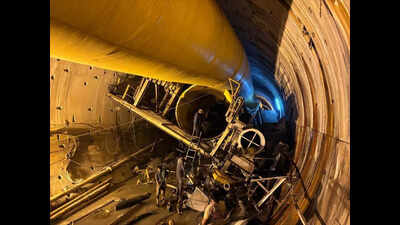- News
- City News
- Hyderabad News
- SLBC rescue operation sets benchmark for tunnel emergency protocols
Trending
SLBC rescue operation sets benchmark for tunnel emergency protocols
Hyderabad: The challenges and experiences encountered during the ongoing Srisailam Left Bank Canal (SLBC) rescue operation are expected to serve as a vital reference for managing similar tunnel-related emergencies in the future.
According to Telangana special chief secretary (disaster management) Arvind Kumar, these insights will aid the National Disaster Response Force in formulating standard operating procedures (SOPs) for tunnel rescue missions. A draft SOP is currently in preparation and will soon be submitted to the National Disaster Management Authority.
Official sources described the SLBC tunnel collapse as unprecedented in complexity and scale. Spanning 55 days, it has become the longest tunnel rescue operation in India to date, involving over 20 state and central agencies. This may well be the first tunnel collapse rescue where robots and cadaver dogs (human remains detection dogs) were deployed to trace the missing workers, officials said, highlighting the collaborative nature of the rescue effort.
By contrast, the Silkyara tunnel collapse in Uttarakhand in Nov 2023—which trapped 41 workers—lasted 17 days and concluded with no fatalities. However, in the SLBC case, only two of the eight missing workers have been recovered so far, underscoring the operational challenges faced by the rescue teams.
Another major challenge has been the massive water seepage—an estimated 5,000 litres per minute—creating a waterfall-like condition that further complicates the removal of muck mixed with boulders and metal debris.
Compounding the complexity is the presence of a 1,500-tonne, 150-metre-long tunnel boring machine, which occupied nearly the entire tunnel. Its removal was a painstaking process carried out by South Central Railway workers, who had to cut the machine into sections to extract it.
Restoring the loco and damaged conveyor belt, essential for transporting muck and metal parts out of the tunnel, also posed significant delays. The belt took nearly a week to repair, further stretching the timeline of the operation.
As the state moves toward winding down the operation, the lessons learned are expected to shape national tunnel rescue protocols, enhancing preparedness and response strategies for future incidents.
End of Article
Follow Us On Social Media








